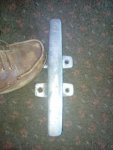pandos
Well-known member
My boat has 4 aluminium cleats 2 each fore and aft. Each is secured to the boat with 4 m8 bolts through countersunk holes in the bases. ( the bolts are each bent so that they sit properly in the cleat and still pass through the cap rail and gunnel ) They are washered and nutted underneath. so fitting new, other than identical cleats will be very difficult indeed.
When removed I discovered that they have been corroding underneath the bases so that they are weakened.
Questions for engineers or others capable of doing calculations regarding shear strength forces etc....,
Q1. Would grinding out the corrosion and filling in voids with aluminium weld return the articles to their original strength, or at least a substantial amount thereof?.
Q2. If I had them bored from the top to accommodate two additional m8 fixing bolts bolts that could then be washered and nutted underneath would I achieve at least the original design strength ?.
Option 2 is to pay approx €650 and buy new from HR and hope they fit exactly which is unlikely. (and I would rather not spend the cash)
Tony.
When removed I discovered that they have been corroding underneath the bases so that they are weakened.
Questions for engineers or others capable of doing calculations regarding shear strength forces etc....,
Q1. Would grinding out the corrosion and filling in voids with aluminium weld return the articles to their original strength, or at least a substantial amount thereof?.
Q2. If I had them bored from the top to accommodate two additional m8 fixing bolts bolts that could then be washered and nutted underneath would I achieve at least the original design strength ?.
Option 2 is to pay approx €650 and buy new from HR and hope they fit exactly which is unlikely. (and I would rather not spend the cash)
Tony.
Attachments
Last edited:

